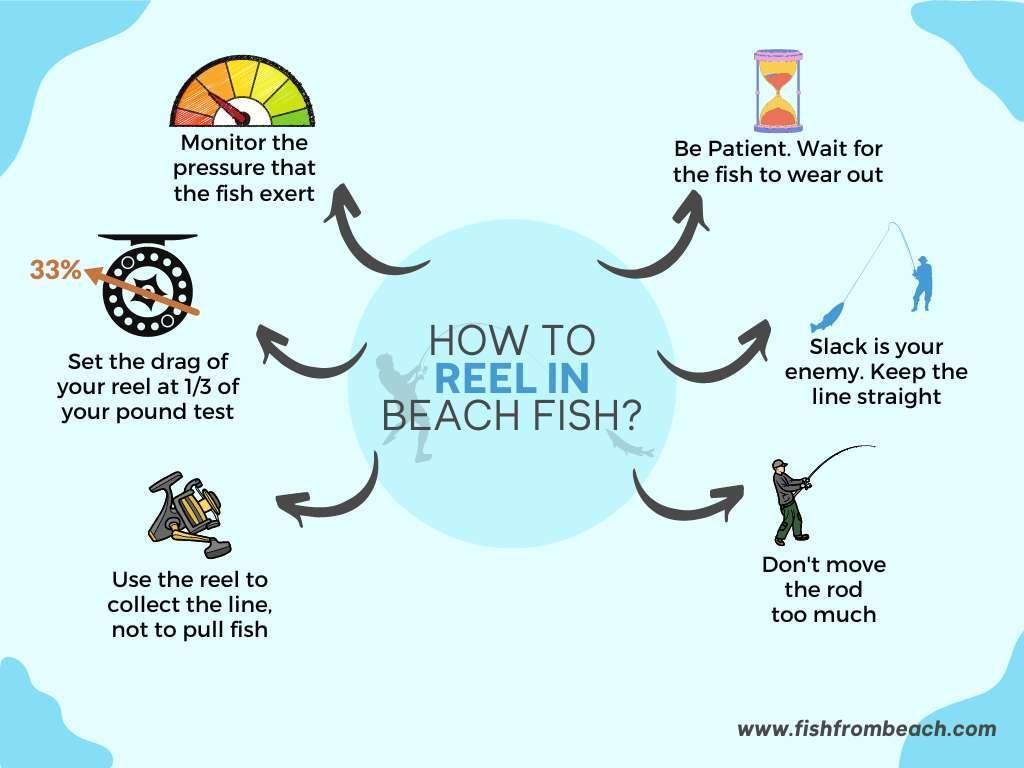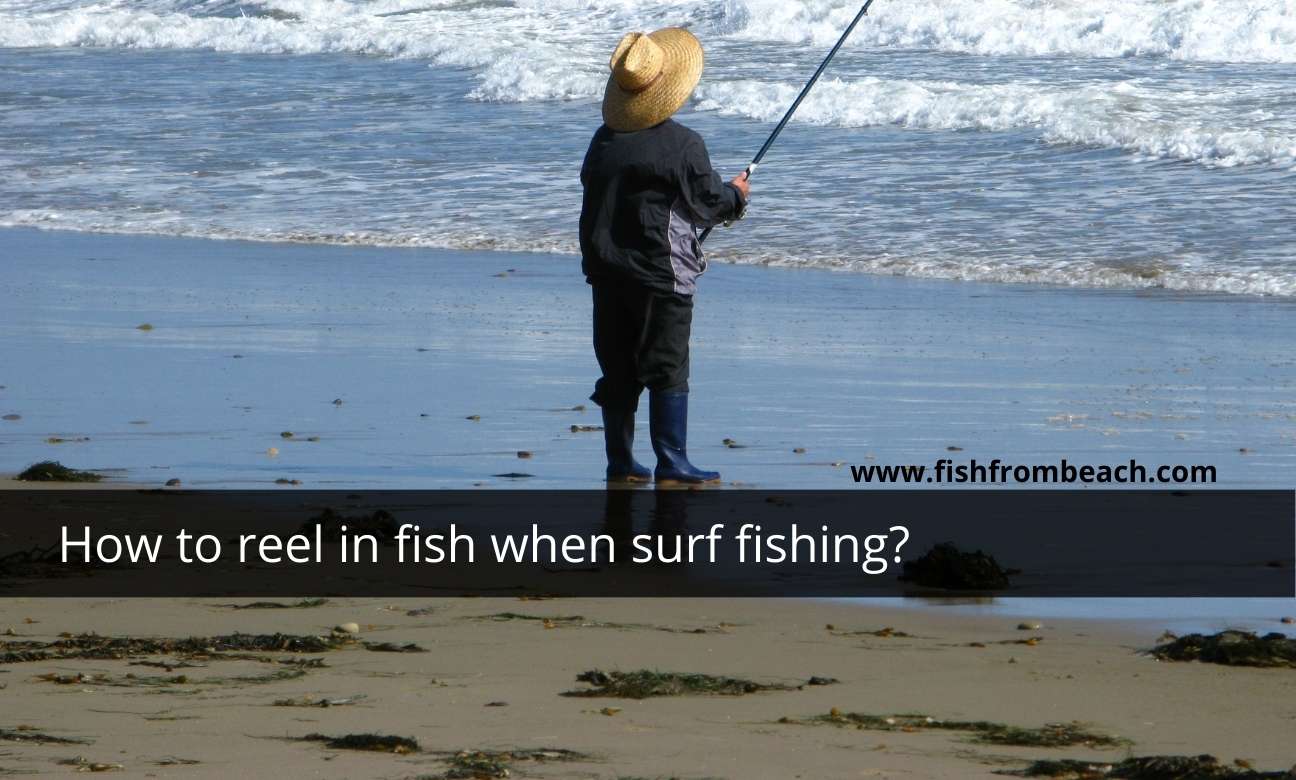Beach fishing can be a relaxing and enjoyable activity for anglers of all skill levels. However, when it comes time to reel in a fish and ensure it successfully reaches the shore, things can quickly get nerve-wracking and difficult, especially for beginners new to the sport.
In this article, we will discuss 6 things to keep in mind when battling and retrieving fish off the beach. The goal is to cover the key principles to remember so that more of the bites you receive turn into tasty meals or, at the very least, memorable photos.
So, let’s get started.
1- Monitor the pressure
When you reel in a beach fish, you must maintain an optimal level of pressure that is high enough not to let the fish run, and at the same time low enough not to tear the hook out of the fish’s mouth.
Now let me clarify something here. Pressure monitoring is a crucial skill in surf fishing, but it takes years of practice and many mistakes to truly become an expert at it.
There is no book or tutorial that can teach you that. So if you’re a beginner, don’t be too harsh on yourself and allow sufficient time for learning.
That being said, it should be noted that the sensitivity of your gear can compensate for your lack of skill and experience.
Meaning, when your gear is sensitive and responsive, you will quickly and easily feel the ups and downs of pressure and therefore be more able to make the necessary adjustments at the right moments.
By sensitive gear, I primarily mean a fast action rod and balanced reel/rod combo.
Braided lines also improve sensitivity, but their non-stretch characteristic may create unnecessary pressure spikes. So I don’t really recommend braid for beginner anglers.
2- Patience, patience, patience…
I’m sure you have heard or read this before: Fishing teaches you patience and without patience you cannot be a successful fisherman.
Well, unsurprisingly, this also applies to beach fishing.
Patience is primordial when surf fishing. Not only when waiting for bites, but also when fighting fish.
In short, never rush your catches out. Meaning, give your catches some time to gradually wear out and burn all the calories in their energy tank.
A tired fish is much easier to pull and won’t cause much trouble down the road. Conversely, trying to reel in a beach fish while it’s still strong often ends up by losing the trophy.
3- Set the right drag
Feeling the fish resistance is the main thing to do in battles, especially in the early rounds.
The process is quite simple, when you feel the fish settling down and not giving a fight, or when you feel it moving shoreward, pull the rod and then try to collect as much line as you can.
But once you sense the resistance again or the fish pulling the line seaward, stop everything and let your drag optimize the pressure for you.
An optimal drag setting is therefore very helpful here.
The role of the drag system during a fight is extremely important.
First of all, it limits the release of line and keeps enough in your reel.
This resistance is also what tires up the fish and makes them easier to drag. Without it, even the lightest species will be able to spool out your reel and escape the trap leaving you with an empty spool.
At the same time, the drag also protects your line and rod when things get too heavy by allowing the line to go off.
Now while the drag is a smart mechanism itself, you still need to do the math and keep it optimal for your fishing conditions and objectives.
As a good rule of thumb, keep the drag at 1/3 of your line strength.
This means if you are using a 15lb line, keep the drag at 4-5lb. You can increase this amount if you find that you are losing too much line, but never exceed the actual pound test of your line.
In other words, if your line is 15 pounds, don’t set the drag higher than 15 pounds because you risk losing the line if a heavy fish (over 15 pounds) takes your bait.
So start by determining the best pound test for your line, then use the ratio (1/3) to set the drag.
This ratio is high enough to provide the resistance needed to tire out the fish you’re chasing and make them beatable, and at the same time low enough to protect your line in stress moments.
Ok, but what happens if I don’t set the drag correctly?
Well, as we said, if you set the drag too low, even the smallest species will be able to take all your line.
In other words, with a loose drag, there won’t be enough resistance to limit the release of line and therefore you risk wasting all your spool even if a perch-sized fish takes your bait.
Not something to be proud of 😀
On the other hand, if you overtighten the drag, the reel will require more stress to release the line and, therefore, will receive more pressure during fights.
This pressure will then be transmitted to your arms, shoulders and back and as a result cause fatigue. Meaning, having the right drag is also important for your comfort and helps you stay productive longer on the beach.
Also, if your line can handle more weight than the rod, setting the drag too high can cause the rod to break in stressful moments.
I invite you to read this article where we explain everything you need about adjusting the drag for beach fishing.
4- Keep the line tight
When fighting a fish, keep your eye on the line all the time. The goal is to avoid slack moments and reel in the line as soon as it starts to form a bow.
A loose line allows fish to move freely and try different head movements to free their mouths.
Not only that, but a loose line also allows fish to enter covered areas where snags and cut-offs are more frequent.
So keep the line straight, not too tight, but tight enough to avoid the above problems.
Many things cause slack line when surf fishing: the wave/wind action, the current, the didal movements, etc. But when reeling in a beach fish, the most common cause is the movement of the fish itself.
Simply put, when fish head seaward, they make the line straight and tight, but when they head towards the shore, they make the line loose.
This is another reason why your gear needs to be sensitive. Sensitive equipment is more effective at transmitting the vibrations created by the fish to the other end of the line, allowing the “too loose/too tight” moments to be anticipated before they cause problems.
In other words, you want your gear to be sensitive and responsive so you can feel the resistance of the fish and adjust the pressure on your side and keep it at an optimal level.
This kind of feedback is so important for all kinds of fish, but it’s most critical when tackling the big species that put so much stress on the line.

5- Reel in correctly
The line retrieval is an important skill to master as a surf angler.
This is because the phase between when the fish bites and when you land it on shore dictates much of your success. Underperforming at this phase risks to cost you what could be your greatest catch ever.
You can’t imagine how many trophies surf anglers lose when they think they’ve already secured the catch.
So when your rod starts to shake, know that it’s not the end of the fight. You still have a tough round ahead of you, and it takes some solid skill and knowledge.
The first thing to remember here is that you should never use the reel to pull the fish.
Your reel, although it looks tough, was only designed to pick up the line, not to lift weights. Therefore, you should never rely on the power of your reel to gain control over fish.
Instead, pull the fish with the rod and then use the reel to collect the slack and excess of line. In other words, when fighting fish, the process you should follow most of the time is:
- When there is no resistance, pull the fish with the rod.
- Once you start feeling the resistance again, slowly (I mean very slowly) lean the rod seawards while gently collecting the line
- Repeat
That’s the safest process to keep your reel in good condition and maximize your chances of getting the catch.
Exerting too much stress on the reel by dragging fish inshore can compromise the inner parts of the reel and, as a result, shorten its lifespan.
Make no mistake about the previous point. Yes, you have to use the rod to drag the fish, but this only applies when they are is still in the water.
Once the fish reaches the land, use your hands to lift it, not the rod.
Lifting fish (especially larger ones) with the rod puts it under significant stress and therefore initiates its damage.
So if you want to take pictures with your catch or show it to your friends, first unhook it, put the rod on the spike, then go celebrate.
6- Don’t move the rod too much
The last thing to remember when you reel in a beach fish is to keep the rod’s tip at the same angle most of the time.
That’s not to say you shouldn’t move the rod at all, but don’t move it too much and avoid jerky movements as much as possible.
Such movements create sudden pressure spikes and drops and therefore give fish a chance to escape.
So when moving the rod, do it extremely slowly while carefully collecting the line to remove any slack generated in the process.
Conclusion
Reeling in a fish is a crucial part of the beach fishing experience and can determine whether you end up with a delicious meal or a frustrated and empty line. In today’s article, we covered 6 important things to keep in mind whenever a battle is about to start with a fish that took your bait.

By executing these points well, you will not only reel in your beach fish successfully, but also enjoy the full fishing experience with confidence.
Some recommended surf fishing gear(*)
Note (*): If you make a purchase through links from this website, we may get a small share of the sale from Amazon or other similar affiliate programs.
Surf Fishing Survey
Help us provide you with better content by answering simple questions about your surf fishing experience and knowledge.
We will put the collected responses together and turn them into valuable information that will help you catch more fish from shore 😉
Note: No personal information will be collected with your answer.

